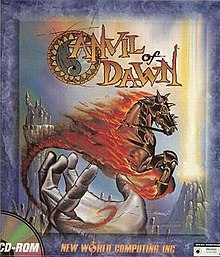
I Got a Rock
I’ve been a gamer as long as I remember, and have a semi-eidetic memory with regards to certain titles, and spent a sizeable portion of my youth gaming on the variations of PCs my family has had. However, I had limited experience with regards to computer RPGs, although several decades ago, I discovered a game installed on the computer called Anvil of Dawn, of which I only played a smidgeon, and given its somewhat quirky title, making me think of a Looney Tunes cartoon, it remained engraved in my memory. However, it would only be recently that I got the chance to play the game to completion, accessing it through Good Old Games, and it’s definitely a unique experience despite its flaws.
Anvil occurs in the world of Tempest, where an evil warlord has overrun civilization, and the forces of good hold out, with one of five different playable characters tasked with saving the land. It’s a typical “save the world from evil” plot, but has some decent backstory, with potential variations depending upon the chosen protagonist, although none of them contain a particularly-high degree of development. There are also potential differences in the ending, although one needn’t go through the game all over to see them. The plot certainly isn’t a repellent, but isn’t great, either.
The game plays strictly in the first person, with the chosen protagonist able to equip armor, weapons, and an amulet, with enemies occasionally encountered in the many dungeons, the player able to hack away at them repeatedly, although foes get their own chances to deplete the player’s health. The chosen character also obtains a variety of mana-consuming spells. Offing enemies with weapons gives the player weapon experience, and using spells gives magical experience, a certain number of points allowing the player to invest one skill point into a type of weapon when they achieve a level, and a point into different magical elements after achieving one magic level.
The gameplay never becomes terribly complex, which isn’t a bad thing, and there is room for error, with symbols allowing the player to restore health and mana at special shrines found in most dungeons. Enemies also don’t respawn most of the time, so odds are if a player kills an enemy, they’re gone for good. Foes may occasionally drop items, with treasure chests also providing various goods, although there is no standard shop where the player can pawn unwanted items, with a battle penalty for exceeding a certain weight limit. Battles are generally fast, and an interesting quirk is that there is no final boss battle, and while the mechanics have issues, they work decently.
Dungeon exploration, like combat, is strictly third-person, with the game luckily having automaps for each area, and the player can type notes on the map if needed. Anvil’s main puzzles come in the form of pressure plates the player needs to weigh down with rocks, which can easily tax their inventory weight limit. Certain items are also necessary to advance the central storyline, and as there is no fast-travel feature among visited areas, the player can potentially spend a lot of time backtracking if they miss a critical plot point. The inventory can also become visually chaotic, and overall, the game doesn’t interact with players as well as it could have.
Much of the music in Anvil of Dawn is actually fairly enjoyable, unusual for a Western RPG, although most of it is rather unmemorable, with a lot of silent portions and occasional glitches regarding the audio. The sound effects are good, and while the voice acting probably didn’t win any awards, it’s somewhat bad in an enjoyable fashion, and the game is moderately easy on the ears.
That the game remains strictly in the first-person is the main strike with the visuals, alongside the aforementioned issue with the graphical chaos of the inventory system, although the art direction is largely good, and there are occasional advanced three-dimensional effects such as the overworld in between dungeons. There’s also a lack of reskinned enemies, although there is plenty of pixilation, and while the game isn’t an eyesore, it could have used more visual polish.
Finally, the game will last players somewhere from one to two days’ total playtime, with some lasting appeal in the form of the different playable protagonists with divergent playstyles and variations in the plotline, although there’s no New Game+.
In summation, Anvil of Dawn was a good game for its time, with serviceable gameplay, some good music, and significant lasting appeal, although it really doesn’t excel across the board, given the issues with the mechanics, the repetitive pressure plate puzzles, the unmemorable plot, and the lack of polish with regards to the sight and sound. Despite its flaws, I definitely don’t regret playing the game, which one could consider a classic among computer RPGs, and the lack of influence from tabletop roleplaying games is certainly a boon, and it’s worth a glance, if nothing more.
This review is based on a playthrough as Daganoth.
The Good:
+Gameplay gets the job done.
+Some good music.
+Significant lasting appeal.
The Bad:
-Weak control.
-Unmemorable plot.
-Sound and sight don’t excel.
The Bottom Line:
An okay game for its time.
Score Breakdown:
Platform: PC
Game Mechanics: 6.5/10
Controls: 3.5/10
Story: 5.0/10
Music/Sound: 6.5/10
Graphics: 6.5/10
Lasting Appeal: 8.0/10
Difficulty: Moderate
Playing Time: 1-2 Days
Overall: 6.0/10
No comments:
Post a Comment